Corpse Photos
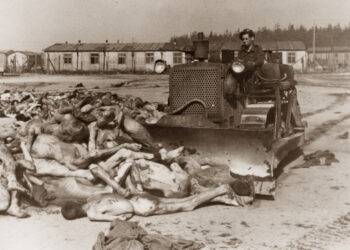 Bodies of typhus victims at the Bergen-Belsen Camp being pushed by a British bulldozer into a mass grave. To this day, these piles of dead bodies are falsely portrayed as the result of a deliberate German policy of extermination. (Click on image to enlarge.)
Bodies of typhus victims at the Bergen-Belsen Camp being pushed by a British bulldozer into a mass grave. To this day, these piles of dead bodies are falsely portrayed as the result of a deliberate German policy of extermination. (Click on image to enlarge.)
In the majority, these are victims of an Allied air raid on the Boelke Barracks at Nordhausen. Among them are also victims of the camp’s appalling hygienic, sanitary and healthcare conditions. This resulted from overcrowding and the inability of the German authorities to provide the inmates with anything due to Germany’s complete collapse in the final months of the war. The bodies were lined up by U.S. soldiers for this photo and a corresponding film, to falsely portray these dead bodies as the result of a deliberate German policy of extermination. (Click on image to enlarge.)
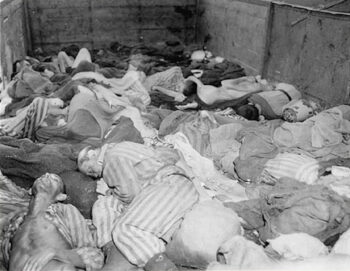
Victims of an Allied strafing raid on an evacuation train full of camp inmates on the way to the Dachau Camp. U.S. troops who found that train misinterpreted the bullet holes in the rail cars and bullet wounds in the dead bodies as the result of a German massacre using machine guns. They subsequently executed all camp guards that had not already been lynched by the inmates. (Click on image to enlarge.)
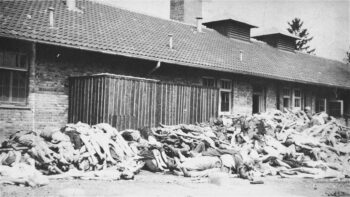
Bodies piled up in front of the crematorium at the Dachau Camp. More corpses were piled up in the morgue inside. These victims were the result of diseases and exhaustion, resulting from overcrowding and the inability of the German authorities to provide the camp with anything due to Germany’s complete collapse in the final months of the war. Due to a lack of fuel, these bodies could not be cremated. To this day, these piles of dead bodies are falsely portrayed as the result of a deliberate German policy of extermination. (Click on image to enlarge.)
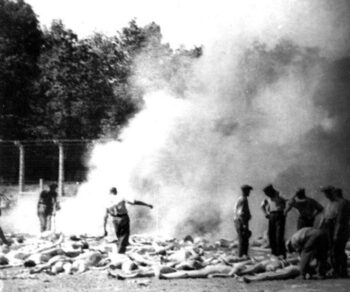
Photo allegedly taken by a member of the Polish resistance group at Auschwitz–Birkenau, presumably from one of the doors of Crematorium V. It shows a few dozen bodies on the ground in front of a smoking pit. However, several features reveal this clearly as a drawing, not a photo. (Click on image to enlarge.)
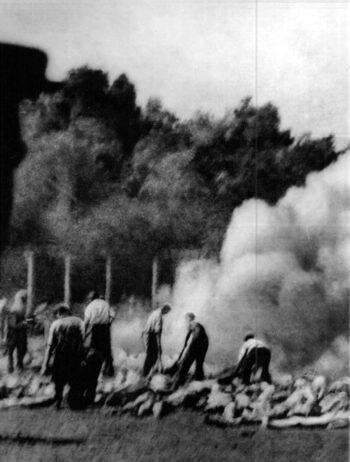
The second photo allegedly taken by a member of the Polish resistance group at Auschwitz–Birkenau, also showing a few dozen bodies on the ground in front of a smoking pit. Several features of this image also reveal it as a drawing, not a photo. (Click on image to enlarge.)
Photos of dead bodies said to have been taken inside German wartime camps are often used to bolster orthodox claims of a National-Socialist policy of extermination. The photos most frequently presented by scholars and in mass media were taken by armed forces of the Western Allies as they liberated those camps. Most prominent among them are photos from Bergen-Belsen, Nordhausen, Dachau and Ohrdruf.
All of these images show the devastating effect which Allied carpet bombing had on Germany. Germany’s infrastructure completely collapsed, and no one could receive anything – neither the civilian population in towns and cities, nor the inmates in prisons and camps. The camp administrations were powerless against malnutrition, hunger setting in, and vermin and diseases spreading. Drinking water supplies dried up or went bad, spreading dysentery and typhoid fever. Medical supplies and fuel were no longer available. Inmates died everywhere, as did the German civilian population in the bombed-out cities, and the millions of Germans expelled from their homes in Eastern Europe and East Germany.
Germany as a whole was, in effect, a rapidly growing pile of corpses. Today, we only tend to get shown the photos from the camps. We don’t see the hundreds of thousands of bombed, burned and gassed civilians in the cities, or the millions of Germans starved to death, dead from exhaustion, or slain when driven from their ancestral homes in East Germany (Eastern and Western Prussia, Pomerania, Silesia), the Sudetenland, Czechia, Poland and from what once was Yugoslavia.
For more on this, see the documentary Probing the Holocaust (Rudolf 2017).
Famous photos published by the Soviets include one taken at Majdanek showing partial skeletons in front of cremation furnaces. (See the Majdanek section of the entry on crematoria.) Another prominent set of Soviet photos was taken at the Klooga Camp. They presumably show dead inmates piled up on an unlit cremation pyre, but this is actually a staged scene with living people. (See the entry on the Klooga Camp.)
Two images are said to have been taken by an inmate from inside the Auschwitz–Birkenau Camp sometime in 1944. However, these images clearly are, at best, heavily retouched photographs, but more likely drawings. But even if they were real photos, they prove only that a few dozen bodies were once lying behind a crematorium, and that something was burning in the background. This is a far cry from the claim that thousands upon thousands are said to have been cremated in the open on huge pyres, darkening the sky. (For more details, see Rudolf 2023, pp. 341-344, 540.)

You need to be a registered user, logged into your account, and your comment must comply with our Acceptable Use Policy, for your comment to get published. (Click here to log in or register.)